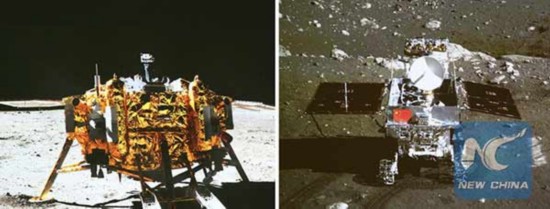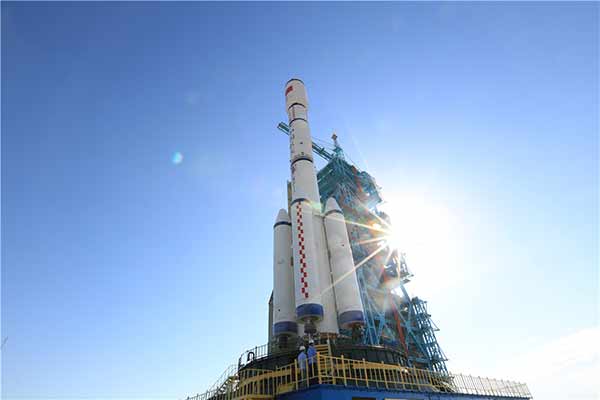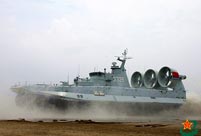

Tiangong, literally meaning "heaven palace", a phrase in ancient China people describe the sky afar.
In March 2016, Tiangong-1 terminated its data service after an operational orbit of 1,630 days, completing its main missions. It had successfully docked with the Shenzhou-8, Shenzhou-9 and Shenzhou-10 spacecraft and undertaken a series of experiments.
China's lunar probe program, or Chang'e program, was approved in January 2004.
According to Ouyang Ziyuan, the country's chief scientist for the lunar probe project, the program includes three phases.
The first phase is launching lunar orbiters; the second is to soft land on the moon and the last phase is taking samples of the moon and bringing them back.

Screen shows the photos of the Chang'e-3 moon lander (L) and the Yutu moon rover during the mutual-photograph process, at the Beijing Aerospace Control Center in Beijing, capital of China, Dec 15, 2013. [Photo/Xinhua]
By far, The Chang'e-3, incorporating a robotic lander and China's first lunar rover, as the second phase of China's lunar program, has already completed its mission and retired on Aug 4, 2016.
During phase two, the Yutu rover will survey the moon's geological structure and surface substances, while looking for natural resources. It would be the first time China has soft-landed a spacecraft on a celestial body.
The spacecraft was named after Chang'e, the goddess of the Moon in Chinese mythology, and is a follow-up to the Chang'e 1 and Chang'e 2 lunar orbiters. The rover was named Yutu, or Jade Rabbit, following an online poll, after the mythological rabbit that lives on the Moon as a pet of the Moon goddess.

The silhouette of Yutu on the moon with the earth as background. [Photo from Yutu's official Sina Weibo]
Yutu has been operating on the moon for over two years, lasting longer than the Soviet Union's 1970 moon rover Lunokhod 1, which spent 11 months on the moon.
In phase three, China's unmanned probe would return with lunar soil and rock. The timetable of the mission has not been specified, but earlier reports said it may be concluded by 2020.

Tiangong-2, China's second space lab, aboard the CZ-2F rocket carrier, is transferred to the launch pad at the Jiuquan Satellite Launch Center in Gansu province on Friday.[Photo by DA KE/ FOR CHINA DAILY]
The most updated news on China's space mission is China's second space lab, Tiangong-2, which is scheduled to be put into space on Sept 15, according to the China Manned Space Program Office. The space lab was transferred with its carrier rocket to the launch pad at the Jiuquan Satellite Launch Center in Gansu province on Sept 9.
Tiangong-2, which can enable two astronauts to live in space for 30 days, can receive manned and cargo spaceships and will be used for testing systems and processes for space stays and refueling.
With China's marching on its path to space exploration, we may one day encounter goddess Chang'e, through unwieldy spacesuits, saying hi.
 |
 Home-made plane completes test flight in Chicago
Home-made plane completes test flight in Chicago The untold stories of women in the Long March
The untold stories of women in the Long March Female soldiers on Frigate Jingzhou
Female soldiers on Frigate Jingzhou Top 10 most beautiful Chinese athletes in Rio
Top 10 most beautiful Chinese athletes in Rio Shenzhen seizes 549 tons of illegally smuggled clothing
Shenzhen seizes 549 tons of illegally smuggled clothing Chinese actor Wang Baoqiang divorces wife, fires manager
Chinese actor Wang Baoqiang divorces wife, fires manager Hangzhou: host city of G20 Summit
Hangzhou: host city of G20 Summit New hovercrafts debut in landing exercise
New hovercrafts debut in landing exercise Woman sets Guinness World Record with 17-month-long pregnancy
Woman sets Guinness World Record with 17-month-long pregnancy Top 10 livable Chinese cities
Top 10 livable Chinese cities Top 20 hottest women in the world in 2014
Top 20 hottest women in the world in 2014 Top 10 hardest languages to learn
Top 10 hardest languages to learn China’s Top 10 Unique Bridges, Highways and Roads
China’s Top 10 Unique Bridges, Highways and Roads Sino-Russian drills show mutual support
Sino-Russian drills show mutual support Protecting panda habitats involves planting bamboo, lifting neighbors out of poverty
Protecting panda habitats involves planting bamboo, lifting neighbors out of poverty Men from different cultures share their tips, tricks and struggles when trying to pick up women
Men from different cultures share their tips, tricks and struggles when trying to pick up women Muslims celebrate Corban Festival in Beijing
Muslims celebrate Corban Festival in BeijingDay|Week